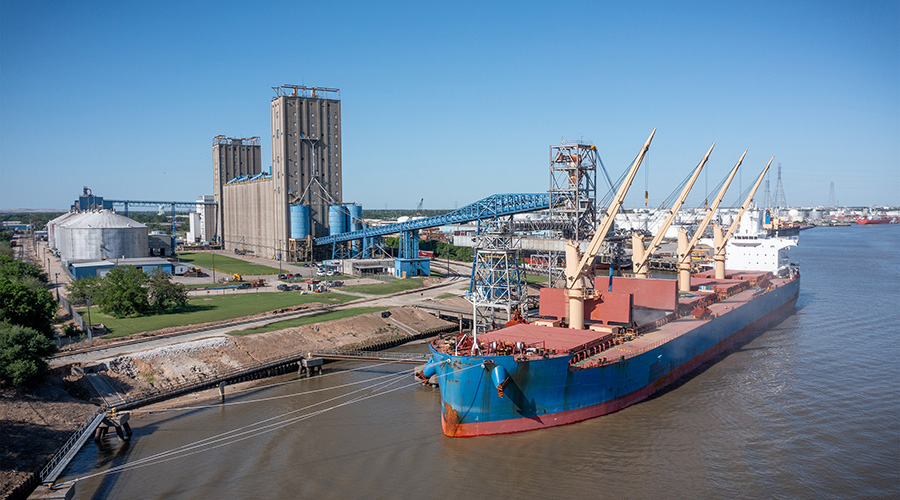Washington state port seeks to restore rail service after a long lull
9/16/2024
By Jeff Stagl, Managing Editor
Something that’s been greatly missed at a Washington state port for more than two decades is on a path to return in the next four years.
The Port of Bellingham is advancing a project to restore on-dock rail service that had ended in 2001, when Georgia-Pacific shuttered its paper pulp mill on the city’s downtown waterfront.
The port recently learned the $45 million rail reconnection project landed a $17.9 million Rebuilding American Infrastructure with Sustainability and Equity (RAISE) program grant from the U.S. Department of Transportation.
The project calls for constructing a 1,575-foot rail spur off a nearby BNSF Railway Co. mainline and building five loading tracks in the port’s Bellingham Shipping Terminal (BST). Specializing in break- and clean-bulk cargos — such as logs and grain — the full-service marine terminal features 1,250 feet of dock space, over 85,000 square feet of covered storage areas and 35 acres of available land.
Scheduled for completion by 2028, the trackage will enable the port to provide direct Class I access to the BST and allow deep-draft vessels to transfer cargo directly to rail at the dock.
“Ports with a rail connection can entertain cargo moving elsewhere in the U.S. and Canada. Ports without a rail connection are only limited to regional projects and cargo activity, which [we] recognized as a limit for activity at our marine terminal,” said Port of Bellingham Public Affairs Administrator Michael Hogan in an email.
The new trackage will connect the BST to 28 states and numerous Canadian provinces via rail. One of 11 deepwater ports in Washington, the Port of Bellingham is located about 20 miles south of the U.S.-Canada border, 90 miles north of Seattle and 55 miles south of Vancouver, British Columbia.
BNSF’s north-south mainline runs through Bellingham, so BNSF will be the local rail-service provider, said Hogan.
 The $45 million rail reconnection project calls for building a 1,575-foot rail spur off a nearby BNSF mainline and five loading tracks in the Bellingham Shipping Terminal. Port of Bellingham
The $45 million rail reconnection project calls for building a 1,575-foot rail spur off a nearby BNSF mainline and five loading tracks in the Bellingham Shipping Terminal. Port of Bellingham“The port is also targeting Canadian customers due to our geographical location and lack of congestion. BNSF would take the rail cars north and Canadian Pacific Kansas City would take the cargo on the other leg,” he said. “BNSF or CPKC will ideally provide rail cars to our mutual customers who will be calling on BST in the future.”
The project will return the BST to a fully functioning multimodal terminal. In addition, the restored rail connection will provide the terminal access to a higher ship call volume, which in turn will create jobs and drive economic development for Bellingham and Whatcom County, said Hogan.
The port estimates that a working rail connection could double the terminal's throughput. Over time, it also would reduce heavy roadway traffic in the area.
“There is no congestion at the BST, which is very appealing to shippers,” said Hogan.
The port plans to use a combination of grants and bonds to pay for both the rail reconnection and a BST modernization project, including the RAISE grant and a $6.85 million federal Port Infrastructure Development Program grant. Future revenue would pay for any debt service on the bonds.
Scheduled for completion by 2027’s end, the $27.5 million BST modernization project calls for fortifying the main dock to accommodate heavy cargo and equipment, increasing the navigation depth to support a much wider range of potential cargo and installing a state-of-the-art stormwater management system to protect Puget Sound.
“We will soon have the navigation depth, laydown space and rail capacity to support a variety of industries,” said Hogan. “The short transit from Asia to the U.S. West Coast also is an advantage — the need to not transit the Panama Canal saves money and time.”
Engineering and design work on the rail reconnection is expected to start early next year. The current project schedule calls for breaking ground in late 2025 or early 2026, but the schedule will be dependent on permitting, said Hogan.
 Bellingham is a coastal city and the shipping terminal is a cornerstone of the community’s working waterfront. Port of Bellingham
Bellingham is a coastal city and the shipping terminal is a cornerstone of the community’s working waterfront. Port of BellinghamAnother reason the project is vital: Trucking is cost prohibitive for volume cargo and creates more carbon emissions and road maintenance, he adds.
“The rail connection checks a lot of boxes that are important to our community,” said Hogan.
The port has spent the better part of the past two decades trying to bolster and refine its infrastructure. When the pulp mill shut down, Georgia-Pacific left behind a footprint of historic contamination in the surrounding land and water that restricted vessel access to the BST and limited cargo operations, causing the terminal to fall into disrepair, said Hogan.
In 2016, the port completed one of the largest cleanup projects in state history, removing pollution from the Whatcom Waterway and restoring limited navigation access to the BST, he said.
The port then began to invest in the equipment and infrastructure needed to modernize the terminal and hired a marine terminals business and development manager.
“The port continues to invest in cleanup and construction projects necessary to fully activate the BST and restore it as a cornerstone of Bellingham’s working waterfront,” said Hogan.
Meanwhile, the port also is advancing an electrification project that’s scheduled for completion in 2026. The project involves creating shore power that will enable ships docked at the BST to plug in to the electrical grid rather than relying on diesel engines and onboard generators.
The port recently was awarded a $2.8 million state grant for the project through Washington’s port electrification grant program.


